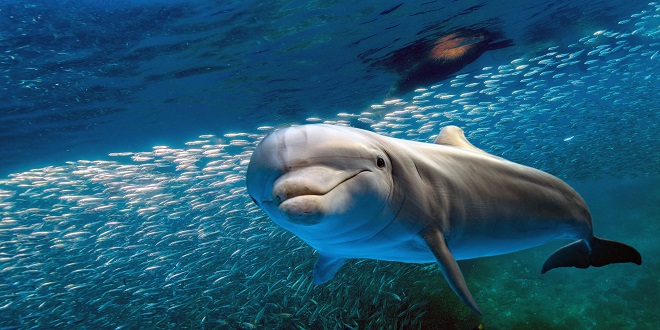Why are Dolphins Important to The Ecosystem

They are beautiful to look at with their smooth bodies that float gently under the water. Dolphins quickly grab the attention of all who see them. They smile with their beak-like nostrils and perform amazing water flips. Dolphins are one of the most charming animals on Earth. They are also undersea predators, despite their friendly exterior.
People must recognize the importance of dolphins to the ecosystem as many changes are threatening our environment. They are adorable and play a vital role in maintaining underwater life. The survival of the marine ecosystem and its balance is at risk without these adorable animals.
The Various Dolphin Species
Let’s first understand the basics of why dolphins are so important.
Dolphins are odontocetes which means that they have teeth. They can be divided into five families with ocean dolphins having 38 species and river dolphins having 4 families each with 1 species.
Ocean Dolphins
Ocean dolphins can be found all over the globe, from the equator down to the ice caps. There are 38 species of ocean dolphins, with the majority living in warm and tropical waters. They can range in size, from the smallest (tucuxi) and the largest (New Zealand dolphins and orca), to the largest (false killer whale and pilot whale).
Giant dolphins are at the top of the dolphin food chain. Spotted, striped and spinner dolphins are also available in white-beaked, hourglass, bottlenose, Heavisides, Hectors, Frasers, Frasers, Clymene, Australian humpback and Australian snubfin.
Each species is distinguished by more than just their size. There are also varying tooth counts. Risso’s dolphins are the smallest (14), while spinner dolphins are the largest (240). Based on the target, their tooth sizes, forms and placements can change.
The most intelligent species of ocean dolphins, bottlenose dolphins, are among the most intelligent. They can communicate with other species such as humpbacks and have complex communication skills. Many boat tours take place in Johns Pass to see them. According to Whale and Dolphin Conservation (WDC), Bottlenose Dolphins can see themselves in mirrors.
River Dolphins
In 2007, scientists declared the Yangtze river dolphins dead. Although there were four river dolphin family members, only three are alive today. The Franciscan, South Asian river Dolphin, and Amazon River Dolphin are the remaining dolphin families. They can all be found in different freshwater bodies.
Although marine dolphins are believed to be their ancestors they do not look like them. They are small in size, have small eyes and beaks, have underdeveloped dorsal fins and flexible necks. These traits are largely due to the millions of years of evolution that took place in freshwater environments.
River dolphins, like other species of ocean dolphins, are in danger of extinction. They are actually more vulnerable because they live in a restricted freshwater habitat. River dolphins are at risk of extinction due to the destruction of their environment and continued killing.
What is a Dolphin’s Niche
How do dolphins help the environment? They play an important part in the environment, just like other wild animals. They are an integral part of the world we live in.
Each of the listed dolphin species is important for their ecosystems. One of these species can be wiped out, which can have a major impact on the equilibrium of the ecosystem.
Let’s explore the question “What does dolphins mean?”
Dolphins serve as environmental indicators.
Researchers can determine whether the ecosystem is balanced by the existence of wild dolphins.
Let’s take a look at the bottlenose dolphin species. The marine life food chain is maintained by this dolphin’s niche.
Bottlenose dolphins love jellyfish, fish, jellyfish, and small aquatic creatures. They also serve as prey to larger predators such as sharks and whales.
Their victims would be more numerous and their predators wouldn’t have enough food. Without them, the biological equilibrium of the water bodies where these cute bottlenose dolphins live would be disturbed.
The contaminated seafood is eaten by dolphins.
The safety of marine animals and humans is enhanced by dolphin ecology. Because they feed on unwell or sick fish that are easy to trap, this is why. This allows for the elimination of certain viral diseases in fish populations.
Ciguatera toxins can be fatally infected fish. If they are consumed, they can cause food poisoning, nausea, vomiting, and other neurological and cardiac problems. We have less chance of eating contaminated seafood when there are dolphins around.
Marine research is made possible by dolphins.
Researchers and scientists also benefit from dolphins’ assistance in studying aquatic life. In research on marine organisms, prey and contaminants in water bodies, tissue samples taken from dolphin environments can be used.
Indeed, data from several marine mammals, including the bottlenose dolphin, provided information and data, most of which related to pollution and illnesses. These statistics are vital for the ecosystem as well as public health.
Key Takeaway
As apex predators and ecosystem engineers, marine animals like seals, whales, and dolphins play critical roles in global ecosystems. The survival of the dolphin species and other marine animals depends on the preservation of the dolphin habitat. The ecosystem of marine life is dependent on bottlenose dolphins.




